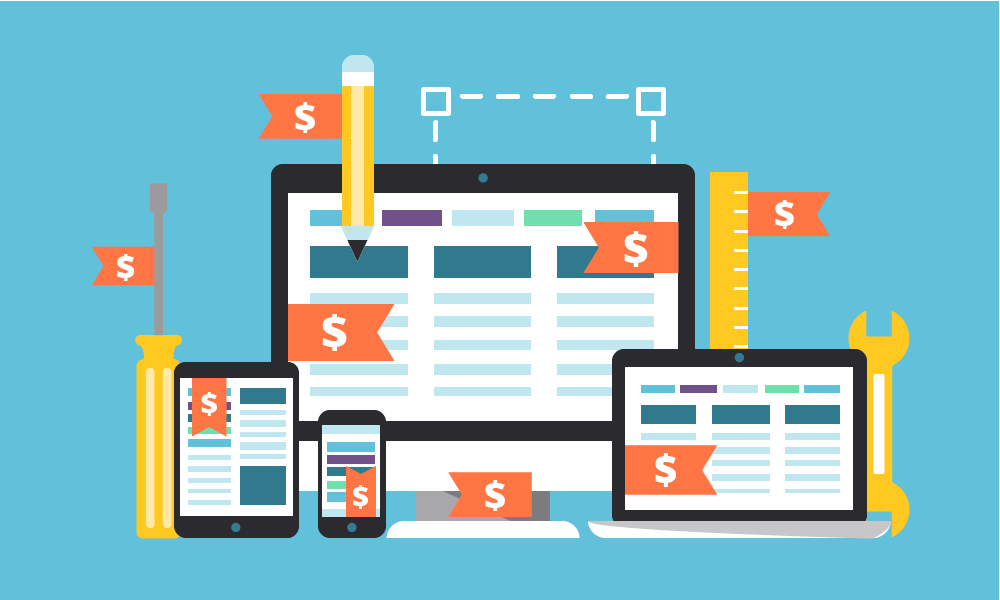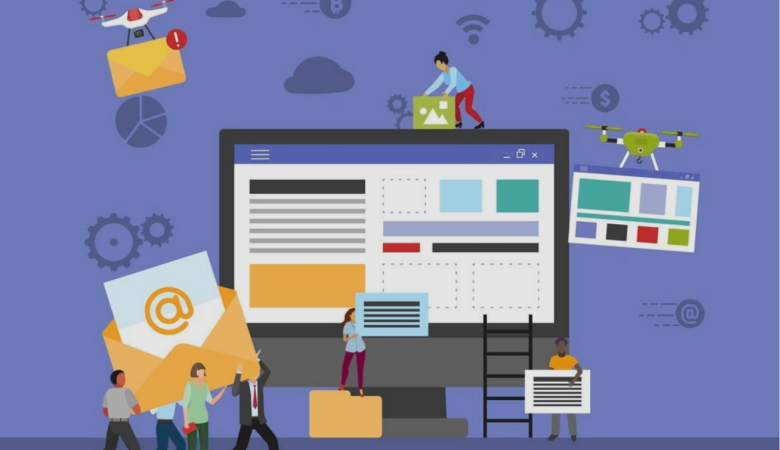This is the question you are likely to be pondering, setting out for website development services. With all the possible benefits and desired functionality in mind, you definitely want your website to provide the greatest ROI possible. Take a closer look at the website development cost structure to make sure nothing slips your mind.

One-time expenses to take into account
Preliminary stage or ordering the meal
However invisible it may seem, precise requirement specification (including project cost and time estimation) is the first cost point. Yet only on paper, the website already needs investments. The more in detail you agree on the website’s functionality and look-and-feel from the very beginning, the fewer reworks will be needed once the solution is ready.
Website design or plating the dish
Website design prices vary based on the required components and supplied media content. For sure, re-using a template is a more cost-effective option than a custom design, but finding a template that will support your brand identity is not so easy.
In general, the website will need universal elements (such as buttons and icons) and content-specific parts. As for the latter, by providing your own multimedia content you cut down on the cost of creation or buying licensed stock images. Still, don’t overlook the need to additionally invest into integrating you multimedia into the overall website design.
Targeting mobile users, you may be considering a responsive design to guarantee convenient interaction with the website across a range of screens. Note that it’s necessary to cover the expenses for every screen size you’d like the website to be compatible with.
Website development or cooking the main course
Development costs depend on a website’s size and capabilities. What’s the number of pages: 10 or 210? Do you need custom functionality? And what about integration with the CRM, ERP, databases, mobile apps, etc.?
Apart from the number of pages, their content matters. Large multi-page websites, complex from the user perspective, can have simpler structure than smaller solutions with a bunch of custom elements. More advanced functionality without doubt costs more. Enhancing your business and enriching user experience, the following features will simultaneously raise the development total cost:
- e-commerce tools (shopping cart, payment processing)
- collaboration tools (forums, chats, contact forms)
- admin features (membership, user management, database reports)
- social media support (Facebook, Google+, Twitter), etc.
How about a money-saving tip? Getting started, define the functionality you need and split it into three groups:
- must-haves for today
- must-haves for tomorrow and
- nice-to-have features
The website is supposed to get the job done. Period. Trendy features will let the website look cool and similar to the popular ones, as well as make set-up costs skyrocket. Planning growth and focusing on the current needs, you’ll stay on budget. Besides, consult with the service provider on the changes in requirements: perhaps, there’s a more cost-effective option to implement a desired idea.
Website redesign or a dinner with your own ingredients
Looking for these tempting minimum redevelopment costs, ensure you don’t get into a mousetrap. Apart from adding new functionality, quality website redesign implies preserving the assets you already have. This means redesign should embrace accurate content migration, keeping your SEO-equity, enhancing performance and scalability.
According to our internal research, content migration may take up to 50% of the overall development costs. Why so? You may choose a new CMS or go for content reformatting due to the prior use of WYSIWYG editors and multimedia that is highly dependent on the website’s layout.
Getting licenses or buying ready-made meals
Once you go for a CMS-based website (e.g. the one on Episerver CMS), the initial payment is extended with license fees. However, the use of powerful CMS systems helps to save money by reducing the development efforts required for complex websites.
What is more, license fees are not only about CMSs, some of the features, such as mailing or payment services based on specific software, are not always free.
Testing or tasting
One more cost point is website testing. For sure, developers involved in the website delivery will do some testing before the solution release. However, as the owner, you are interested in a website that is not only bug-free, but also convenient to the user and secure from intrusion. Then set your alarm clock for the testing time.
Usability testing will show whether the visitor finds your website convenient. Therefore it should be carried out before the solution launch. Ideally, the testing group’s members should be close to your target audience, even though this may increase the cost. Overall, be prepared for two-three rounds of usability testing to get a really user-friendly website.
Penetration testing is to be taken regularly, say, once a year, so as to reinforce existing security controls against a possible intrusion. The testing fees range depending on the time and amount of parameters tested.
On the whole, it’s not a good idea to get usability and penetration testing done by your website developers. Why not? Due to the lack of:
(a) Look from outside
As for usability testing, a person engaged in website design and development will not look at your website from the user perspective without bias, just due to having more knowledge, experience and desire to understand your website.
Penetration testers not engrossed in the website development, will not only use the latest tools, but also look more thoroughly for weak points and vulnerabilities.
(b) Specific expertise
The test results’ quality depends on the testers’ competencies. For usability testing that includes skills to make good tests and elaborate recommendations concerning usability issues. Penetration testing requires experience in defining the intruder model, vulnerabilities detection, visual demonstration of the possible damage and more.
Finally, before the solution is rolled out to the market, you will also need acceptance testing to be sure the website complies with your business requirements provided earlier in the preliminary stage.
Other cost factors or sprinkling the seasoning
Needless to say that delivery deadlines and solution complexity (both in terms of the design and functionality) will affect the total website cost. But there’re some other hidden factors to consider:
Internal team time lags
Make sure your team, involved in collaboration with the developers, reviews and gives feedback quickly. Otherwise, you’ll face additional costs just to cover the extra time spent on ineffective communication. In addition, try to focus on the truly valuable parameters, as nitpicking results in higher costs with almost invisible changes from a website visitor perspective.
Blurred project concept
Many companies provide a definite number of website design patterns, say two or three, as they allocate particular time for the planning stage. The customer’s ever-changing requirements lead to extra creative research and reworks, which results in higher delivery costs. Therefore, to save money, come up with a realistic concept of the future website and stick to it.
Regular costs to keep in mind
A website is not a one-off buy. To enjoy it up and running, you’ll have to make regular payments, either for merely staying online, or for updates to improve the website performance and remain competitive.
The former includes regular payments for the domain name and hosting just to reserve a place for your website in the Net, as well as fees for SEO to ensure your target customer can quickly pick up your website out of many. Unless you are savvy enough to engage in on-site content improvement, link building, keyword research, and optimization, chose a quality service provider to regularly, say, annually, carry out SEO website audit and optimization for you.
The latter, payments for maintenance, cover the bug fixing and updates to adjust to the changing environment, like a new browser launch, or the need for additional functionality to enhance UX and security level. Growing along with your business, the website will also require scalability and performance optimization to handle the soaring number of visitors and data amount.
Overall, to stay healthy, a websites needs money injections on an ongoing basis, which are likely to keep increasing. The larger your website becomes, the more data and visitors it processes, the more resources it requires to be active. Still, this money is just the necessary amount of fuel to keep your online vehicle moving.
Turnkey solution vs a cook-it-yourself approach
Let’s face it. Full cycle website development done by a tried and tested service provider will cost two-three times more than bringing together website parts delivered by small standalone companies. However, as a reward for extra payments you’ll get:
- Worries off: no need to fit together the solution parts by yourself
- Guarantee: confidence in the end solution quality
- Consistency: for instance, the design won’t damage performance or search engine visibility
- Valuable details in focus: as with content migration, no loss of users, traffic, URLs
- Collaboration: your involvement in the development process to get the best-fit website
- Thought-out processes: quick move through the development stages
Overall, despite the reduced initial costs, the construct-it-yourself approach will require from you sufficient IT industry knowledge. Otherwise, you can end up with spending more on reworks than on actual full-cycle development from the start.
Bringing it all together
Planning a website development budget, make sure it covers not only one-time costs, but also the hidden and regular expenses. For sure, you’ll be constantly enticed by the low-cost offerings, but stay skeptical.
In the end it’s up to you to decide whether to cook at home, get a snack in a fast-food cafe nearby, or dine in a Michelin-starred restaurant. However, not every diner will serve both quality and sophisticated dish, and amateurs won’t get the difference until they suffer indigestion.
By Vadzim Belski, Head of Web Development Department at ScienceSoft






This is nice topic and finally find great information about web development.
Great list!! Thanks for sharing.. It’ really awesome for fresher and experience Web developers.
Great points! Now if I can only find more webdesign clients that understand. 🙂
What tools do you use for “usability testing” and “penetration testing” or do you do this manually yourself?
Excellent article! Points mentioned here are unique and very informative for every web developer!
it’s an nice topic very informative and unique because it is an essential part of website that is budget so nice work.